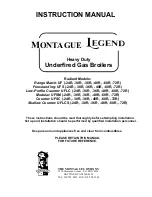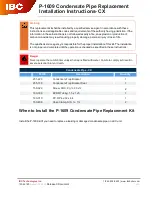
13
NORMAL SEqUENCE OF OPERATION
On a call for heat, the thermostat will actuate, completing
the circuit to the boiler. In turn, the ignition systems
are activated and ignition will begin.
In the event of a low water condition, an automatic low
water cut-off device will interrupted power between the low
water cut-off and the burner. The burner will remain off until
the low water condition is corrected, (i.e., manually restore
boiler water or utilize a water feeder device which will
automatically restore water to its normal operating level).
IMPORTANT TO THE INSTALLER -
Before putting the
Refill boiler to its normal water line.
boiler in operation, test the mechanical low water cut-off
device for proper operation. While burner is on, open the
blow-off valve located in the lower portion of the cut-off
body. This will drain the water quickly from the cut-off body
and break the circuit to the burner. If it does not, replace
control.
!
WARNING
WATER WILL BE BOILING HOT.
OPERATING INSTRUCTIONS
The venting system should be inspected at the start of each
heating season. Check the vent pipe from the boiler to the
chimney for signs of deterioration by rust or sagging joints.
Repair if necessary.
Remove the vent pipe at the base of the chimney or
flue and, using a mirror, check for obstruction and verify
compliance to the latest revision of the NFPA 211.
The lever of the pressure relief valve
(Figure #14)
on the
boiler should be operated periodically to make sure that it is
functioning properly.
MOUNTING
(BOTH SIDES)
LOWER FRONT
JACKET PANEL
PRESSURE RELIEF
VALVE
TOP JACKET
PANEL
1/4" SLOT
BURNER
ELECTRICAL
DISCONNECT
28"
WATER
ELECTRONIC LOW
WATER CUT OFF
INSPECTION
COVER
LINE
SCREWS
HOT
The pressure relief valve should open before the steam
pressure exceeds the 15 lb. reading on the gauge. If this
pressure is exceeded and the pressure relief valve leaks
steam when the boiler is operating at normal pressures, it
should be immediately replaced. Corrosion can build up
rapidly at the valve seat and prevent its functioning as a
safety device.
START-UP AND ADJUSTMENT OF OIL BURNER
(See oil burner instructions for nozzle and electrode setting)
!
CAUTION
DO NOT SET FIRE vISUALLY.
Instruments are the only reliable method
to determine proper air adjustments.
An improperly adjusted burner causes
soot and high fuel bills because of
incomplete combustion of the fuel oil.
This in turn may require excessive
boiler maintenance, service costs, and
in some instances, house cleaning
or redecorating. A competent service
mechanic should be consulted to make
the proper adjustments with a smoke
tester, CO
2
indicator, and draft gauge.
NoTE:
Bacharach or Dwyer test kits include these
instruments.
Check oil burner nozzle to make certain it is tight in
A.
adapter. Burner mounting bolts should be tight.
Check electrode setting, as they may have been jarred
B.
out of position during transportation.
Lubricate burner motor if necessary.
C.
!
WARNING
Discharge will be boiling hot water and
steam.
Figure #14










































